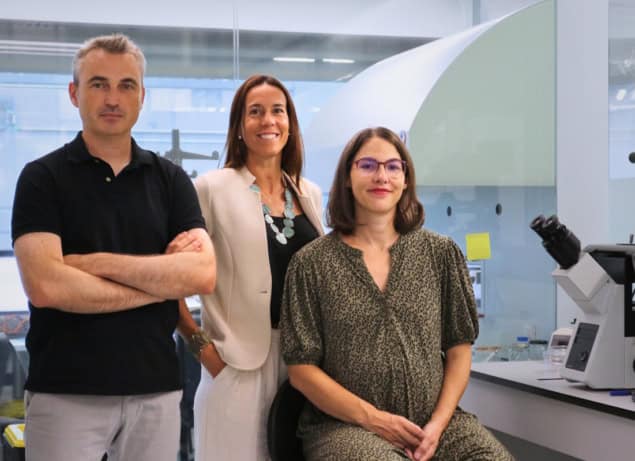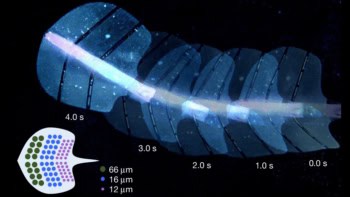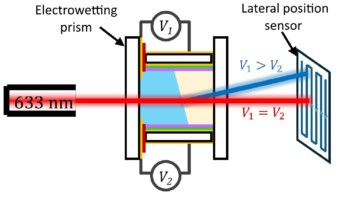Human reproduction is an inefficient process, with less than one third of conceptions leading to live births. Failure of the embryo to implant in the uterus is one of the main causes of miscarriage. Recording this implantation process in vivo in real time is not yet possible, but a team headed up at the Institute for Bioengineering of Catalonia (IBEC) has designed a platform that enables visualization of human embryo implantation in the laboratory. The researchers hope that quantifying the dynamics of implantation could impact fertility rates and help improve assisted reproductive technologies.
At its very earliest stage, an embryo comprises a small ball of cells called a blastocyst. About six days after fertilization, this blastocyst starts to embed itself into the walls of the uterus. To study this implantation process in real time, the IBEC team created an ex vivo platform that simulates the outer layers of the uterus. Unlike previous studies that mostly focused on the biochemical and genetic aspects of implantation, the new platform enables study of the mechanical forces exerted by the embryo to penetrate the uterus.
The implantation platform incorporates a collagen gel to mimic the extracellular matrix encountered in vivo, as well as globulin-rich proteins that are required for embryo development. The researchers designed two configurations: a 2D platform, in which blastocysts settle on top of a flat gel; and a 3D version where the blastocysts are placed directly inside collagen drops.
To capture the dynamics of blastocyst implantation, the researchers recorded time-lapse movies using fluorescence imaging and traction force microscopy. They imaged the matrix fibres and their deformations using light scattering and visualized autofluorescence from the embryo under multiphoton illumination. To quantify matrix deformation, they used the fibres as markers for real-time tracking and derived maps showing the direction and amplitude of fibre displacements – revealing the regions where the embryo applied force and invaded the matrix.
Quantifying implantation dynamics
In the 2D platform, 72% of human blastocysts attached to and then integrated into the collagen matrix, reaching a depth of up to 200 µm in the gel. The embryos increased in size over time and maintained a spherical shape without spreading on the surface. Implantation in the 3D platform, in which the embryo is embedded directly inside the matrix, led to 80% survival and invasion rate. In both platforms, the blastocysts showed motility in the matrix, illustrating the invasion capacity of human embryos.

The researchers also monitored the traction forces that the embryos exerted on the collagen matrix, moving and reorganising it with a displacement that increased over time. They note that the displacement was not perfectly uniform and that the pulling varied over time and space, suggesting that this pulsatile behaviour may help the embryos to continuously sense the environment.
“We have observed that human embryos burrow into the uterus, exerting considerable force during the process,” explains study leader Samuel Ojosnegros in a press statement. “These forces are necessary because the embryos must be able to invade the uterine tissue, becoming completely integrated with it. It is a surprisingly invasive process. Although it is known that many women experience abdominal pain and slight bleeding during implantation, the process itself had never been observed before.”
For comparison, the researchers also examined the implantation of mouse blastocysts. In contrast to the complete integration seen for human blastocysts, mouse embryo outgrowth was limited to the matrix surface. In both platforms, initial attachment was followed by invasion and proliferation of trophoblast cells (the outer layer of the blastocyst). The embryo applied strong pulling forces to the fibrous matrix, remodelling the collagen and aligning the fibres around it during implantation. The displacement maps revealed a fluctuating pattern, as seen for the human embryos.

The surprising physics of babies: how we’re improving our understanding of human reproduction
“By measuring the direct impact of the embryo on the matrix scaffold, we reveal the underlying mechanics of embryo implantation,” the researchers write. “We found that mouse and human embryos generated forces during implantation using a species-specific pattern.”
The team is now working to incorporate a theoretical framework to better understand the physical processes underlying implantation. “Our observations at earlier stages show that attachment is a limiting factor at the onset of human embryo implantation,” co-first author Amélie Godeau tells Physics World. “Our next step is to identify the key elements that enable a successful initial connection between the embryo and the matrix.”
The study is reported in Science Advances.



